Have you have ever encountered a strange and colorful mass growing on mulch or downed logs? Did it appear overnight, especially after a summer rain? If so, you may have seen a slime mold. Despite their common name they are not actually molds and are harmless to plants and animals. Slime molds are amoebas: shape shifting organisms in the Protist kingdom. Their presence is short lived and they are beneficial for soil health and biodiversity. The more we learn about these complex organisms the more we see there is to learn.
Slime molds come in many sizes, colors and shapes based on the species and its life stage

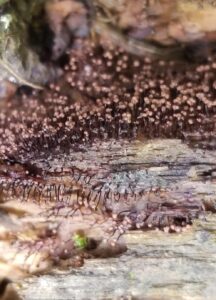
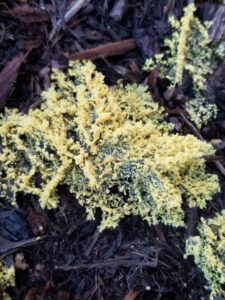
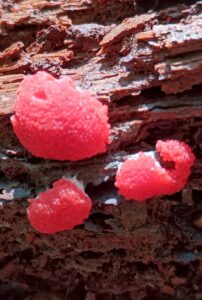
The majority of slime molds that we can see with the naked eye are known as plasmodial slime molds. They begin as individual amoeba-like cells then merge together to form a giant amoeba “super-cell” called a plasmodium. The super-cell contains thousands of nuclei within one cell wall which operates as a single entity. It eats by engulfing fungi and bacteria while slowing moving through decaying organic matter.
Slime molds can move up to an inch per hour. The exact speed depends on the species and its environmental conditions. It pulses and ooze it’s way across the substrate finding microorganisms to eat. When conditions become unfavorable or food scarce, the color will fade as the mass dries up moving into the sporangia stage. During this stage, the spores move by wind or insects to their next location leaving no trace that they were ever there. This whole process is usually occurs over a week or so.
Photos are one day apart: Slime mold going from amoeba-like plasmodial stage to sporangia stage
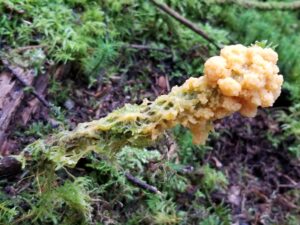
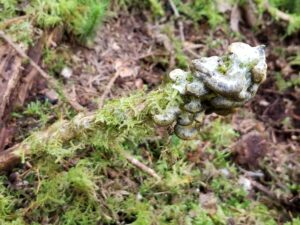
Chocolate Tube Slimes: A genus of slime molds that transforms from clusters of small yellow dots into delicate brown tubes which release spores


Slime molds in the wolf milk complex are bright and squishy for a few days before maturing to a darker color and eventually hardening
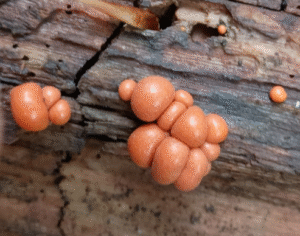

During their brief vegetative/plasmodial growth phase, slime molds may move on or around plants but they do not cause any damage and in fact are beneficial. This is because they are decomposers and release nutrients as they break down their food. They also consume potential soil borne pathogens and produce antibiotics that inhibit the growth of harmful bacteria and fungi.
Slime molds are considered beneficial organisms for environmental remediation. One of the most commonly seen slime molds in gardens and on mulch is the vibrant yellow, Fuligo septica, which has the ability to hyper-accumulate toxic heavy metals and convert them to inactive forms.
Fuligo septica’s vibrant yellow pigment plays a role in rendering heavy metals inactive during its plasmodial stage. The color fades during the sporing phase.
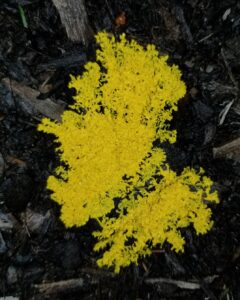
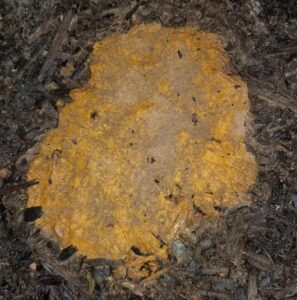
There have been many studies on slime molds, giving insight into how organisms without nervous systems show intelligence. Some scientists have drawn analogies between the patterns/dynamics exhibited by certain slime molds and the synaptic connections in animal brains because of their impressive problem solving skills. Researchers recently discovered that slime mold can use its body to sense objects without making physical contact then decides whether to grow toward them based on their mass and mass distribution.
Slime molds have been placed in mazes where they quickly find the shortest route to food. Slime mold was placed onto a model map of Tokyo with food representing urban centers to see how it would connect these food sources. The slime mold made a network almost identical to Tokyo’s railway system within a day. Since then, slime mold has successfully mapped out the most efficient transport networks of numerous cities as well as recreating a map of Canada’s motorway network.
Slime mold’s network of interconnected filaments during amoeba-like plasmodium stage
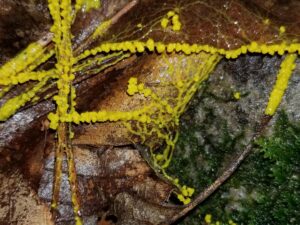
Scientists have also discovered that slime molds can communicate ways to overcome obstacles to each other through cellular fusion. One experiment used salt (which they are averse to) as a barrier to food. The slime mold who learned how to cross the salt could easily teach a newly introduced slime mold how to do the same. The transfer of knowledge occurred when the two fused together for at least three hours before going their separate ways.
The recommendation across the board is to let slime molds be, or even to enjoy their curiosities! No chemical controls are known or needed as they come and go quickly while supporting biodiversity. Although there is much we don’t know about these intelligent and ephemeral organisms, we can still appreciate and be humbled by their complexity and benefits to our surroundings.
Photos and editing by Amy Hill
Sources:
What’s That Yellow Blob on my Mulch? Slime Mold, Fairfax County Master Gardeners
Thinking without a brain,Wyss Institute at Harvard
I Ain’t Afraid of No Slime Mold, University of Florida Extension
Slime Molds, National Park Service
Slime molds transfer knowledge though fusion, Journal of Experimental Biology
Biodiversity: Slime Moulds: The Royal Horticultural Society
The intelligence of slime mold, The Appalachian Voice
Slime mold looks ugly in the garden but does no harm, Oregon State University
Adaptive behaviour and learning in slime moulds: the role of oscillations, The Royal Society Publishing
The mysteries of Myxomycetes: Six scintillating facts about slime molds, Fort Worth Botanical Garden
The blob: Slime molds, Utah State University